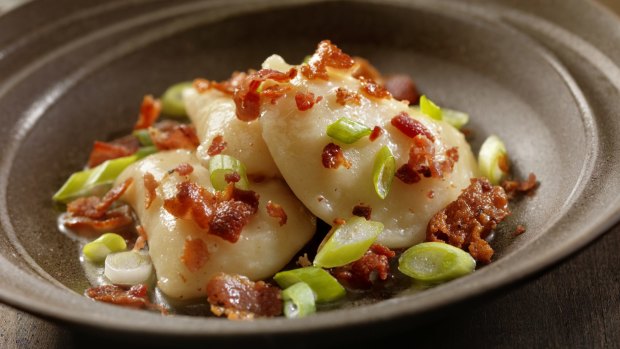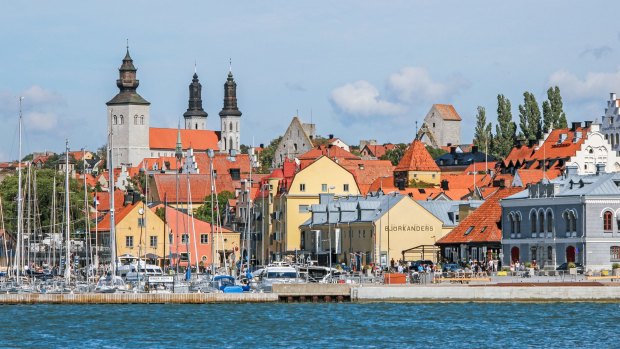This was published 4 years ago
Escape the cruise crowds with these independent shore excursions
By Lee Tulloch

Pierogies with bacon and onions.Credit: IStock
Gdansk railway station is not exactly user-friendly for those who don't speak Polish. Waiting on the wrong platform for the train back to the port of Gdynia, we were a breath away from mistakenly hopping on the fast train to Warsaw. With a cruise ship waiting for us in port 30 minutes away, preparing to sail, it could have turned into a full-blown crisis. Luckily, people were kind, we found the right platform, and made it to the ship in the nick of time.
During the 10-day cruise of the Baltic on Regent Seven Seas Explorer, I had "gone rogue" in every port, that is, created my own shore excursions outside what the ship offered. A Baltic cruise is perfect for an independent itinerary because the destinations include several of Europe and Scandinavia's great cities, all with strong cultural heritage, all with walkable centres and, Berlin aside (more of this later), all easily accessible from the ship. Personalising excursions is a great way of enhancing a voyage, but it requires lots of research, sensible planning and, sometimes, as I discovered in Gdansk, a bit of crisis control.
Starting in Oslo, we sailed to London, then on to Bruges, Amsterdam, Copenhagen, Berlin, Gdynia, Visby on Gotland island, arriving in Stockholm at the conclusion. I'd never been to six of these places; my travelling companion hadn't been to seven, so the cruise was a bit of a "taster" and also an opportunity to visit some icons we'd somehow missed in our travels, such as the Van Gogh museum in Amsterdam.

Visby, Sweden.Credit: iStock
All-inclusive Regent Seven Seas offers free unlimited shore excursions, although there's a fee for special and smaller group tours. Recognising some guests may prefer to be independent, on offer were "London My Way" or "Berlin My Way" excursions via bus, which deposited guests at a point in a city, allowing them a few hours of free time, and then collecting them at predetermined time. I'm not a great fan of large group tours, or big buses, and I'm easily bored listening to guides, so I'm happy to do my own research and play a destination by ear.
Given the limited time at each stop, our plan was to have one art experience and one local culinary experience, with the ship our luxury hotel for sleep, spa, meals and other comforts. In the purest sense, the ship was a practical mode of transport, as entering each place through a seaport is far less stressful than arriving via an airport. (I would have hated nine airport security screenings.) We'd do our 20,000 steps most days and then collapse in the steam room and infra-red sauna in the Canyon Ranch Spa for a recharge before heading out to dinner in one of the ship's speciality restaurants. It was perfect.
We began the cruise in Oslo. Arriving in the Norwegian capital in the afternoon, we checked into the well-located Continental Hotel (see lhw.com/hotel/Hotel-Continental-Oslo-Norway), before dashing to the Astrup Fearnley Museum of Modern Art, which has a beautiful position on the waterfront, to catch a temporary exhibition by the German artist Anselm Kiefer. The weather wasn't exactly warm, but a few locals were lying by the sparkling water, catching the last sunrays of summer. Later, jetlagged, we ate at a glamorous Chinese restaurant, Dinner, before a walk around the centre of the city to get a feel for it.
We boarded the ship the next morning. A sea day followed, which was a good way of exploring all the facilities and checking out the other 748 guests. After we docked in London Tilbury the next morning, we took the cruise-organised bus to the Victoria embankment, conveniently close to our planned museum, the National Portrait Gallery, where an acclaimed Cindy Sherman retrospective was showing. We had booked lunch at Australian chef Skye Gyngell's restaurant Spring in Somerset House, which turned out to be only a few minutes away. The airy, delicate green space was relaxing on a beautiful summer's day and we lingered over a great-value three-course set menu for £31 before wandering back to the bus and then a drive to the ship (see springrestaurant.co.uk/).
The next day, it was Bruges. Again, we chose the "Bruges on Your Own" option, which involved a short bus ride to the edge of town, and then a few hours of free time. Because the well-preserved medieval city is small, there's a lot that can be seen in this time - if you don't get waylaid by any of the sixty-eight chocolate shops (we did.) We got a head start on the other tourists and stumbled across the quiet 12th Century St John's hospital, now a museum featuring a triptych by Flemish master Hans Memling in the chapel, before visiting the Gruuthusemuseum of applied arts, housed in a 15th Century mansion, and worth a visit for its beautiful interiors, collection of antiques and fantastic views from high casement windows. (Lots of little steps, though.)
We made a detour via the touristy Torture Museum (don't bother) before stopping at Relais Bourgondisch Cruyce, a small hotel with a wonderful aspect over a canal, and sat in the window eating plain vanilla waffles, dusted with sugar and light as air. We managed to fit in some double-fried chips in the Markt Square before strolling back to the bus. Luckily there was a juice bar on board the ship to balance out some of our unhealthy food choices on land– because, let's face it, travelling is about cakes.
In Amsterdam, we joined the ship's scheduled Van Gogh Museum tour, raided the excellent gift shop, and then separated from the group to visit the nearby Rijksmuseum, where its most famous painting, Rembrandt's Night Watch, is being mapped by a micro-scanner while it hangs in a glass chamber, a fascinating, multi-million euro restoration project which can also be viewed online (see rijksmuseum.nl/en/nightwatch).
Next, we hailed a taxi (a Tesla, very posh) to The Nine Streets, Amsterdam's chic Left Bank, and ate apple pancakes outdoors at a café on the canal. We took a very long walk back to the port through the city, ultimately pleased that we hadn't done the touristy thing and stopped in a coffee shop for a spacecake or we might never have made it back to the ship.
In Copenhagen, we were crestfallen to discover that the Design Museum Denmark was closed on Mondays. (Tip – if there's something you really want to visit, do check before committing to the cruise that the ship doesn't dock on the day it's closed.) Instead, we strolled from the ship to Rosenberg Castle, King Christian IV's pleasure palace, through beautiful parklands and gardens (stopping to say hi to the Little Mermaid on the way..
We then walked into the city and grabbed a big, sticky cinnamon bun, a breakfast tradition, at Torvehallerne, the large covered market near Nørreport station. Lunch was also traditional, smørebrød, or open sandwiches, at Aamanns 1921, a light-filled restaurant which serves eye-catching smørebrød in new flavour combinations such as beef tartare with hazelnuts or potatoes with fermented gooseberries and geranium, washed down with homemade schnapps or cordial. Afterwards, we didn't have time for a full visit of the enchanting Tivoli Gardens, but I know a secret spot, the terrace of the hotel Nimb, where you can sit overlooking the funfair for the price of a coffee, without paying an entrance fee.
Berlin isn't a port, so to do "Berlin Your Way" we had to spend seven hours on a coach (three hours in, four hours out in traffic). It was too hot to walk around, so we dropped into the amusing DDR museum, which showcases everyday life in the former East Germany, from Stasi listening stations to the recreation of drab housing estate interiors.
A friend suggested the restaurant Joseph-Roth-Diele on Potsdamer Str. for lunch. The favourite place of the local arts crowd at lunchtime, this inexpensive little bistro serving basic but tasty schnitzel, sauerbraten and beef goulash was named after the Austrian Jewish author Joseph Roth, who lived next door before his forced exile in 1933. Dripping with Weimer Republic atmosphere, it is decorated with photographs and books by the author (see joseph-roth-diele.de/)
We felt we must eat pierogi while in Poland, despite the heat, so in Gdansk we joined the lines outside the popular Pierogarnia Mandu Centrum, a modern, Scandi-style space where the menu offers an international selection of dumplings alongside the very good, satisfyingly heavy, potato and onion kind. Servings are enormous, so sharing a plate is recommended. Regretfully, we didn't have space for chocolate dumplings with raspberries and cream. Our day in Gdansk was spent looking for amber jewellery and walking off the pierogis in this small, unexpectedly lovely city, which was carefully rebuilt after 1945 and later was the home of the Solidarity strikes in 1980s.
Gotland is the large Swedish island in the Baltic that's famous for the hoards of Viking silver that locals keep digging up. From the ship it was only a twenty-minute walk through parkland to Visby, a beguilingly beautiful town of painted houses, cobblestoned lanes, walls covered in rambling roses, ruined Gothic churches, little boutiques selling wool, homewares and organic beauty products, and dozens of appealing cafes, many situated in flowering gardens or lining the town square.
We stopped first at the absorbing little Gotlands Museum, which showcases the Viking history of the island (the treasure troves of Viking silver are astonishing.) Then we went in search of saffranspannkaka, a saffron-infused pancake that has the texture of rice pudding and is served with dewberry preserves. By chance, I overheard a local woman talking about a café called Ett Rum För Resande, saying that the Israeli chef made the best pancakes in town, so we nabbed a table inside before the lunch crowds. It was tiny with no table service, but the saffranspannkaka was about the best thing I've ever tasted.
The cruise concluded in Stockholm, where we transferred to the Grand Hotel (see lhw.com/hotel/Grand-Hotel-Stockholm-Stockholm-Sweden), and then set out for the contemporary photography museum, Fotografiska, which occupies the old customs building on the dock at Södermalm. Our local eating experience for lunch was meatballs (of course) at the restaurant Osterlånggattan 17, which is its address in Gamla Stan, the old town.
Working with the ship's resources but to our own agenda worked brilliantly on this cruise. If you want to follow suit, I suggest make realistic plans for what you can attempt in a short time and then prioritise your day, while leaving it open for some unexpected discoveries. And do keep your eye on the clock. There's no way the ship is going to sail to Warsaw to rescue you.
TRIP NOTES
CRUISE
Regent Seven Seas Cruises' Seven Seas Explorer will be sailing a raft of Northern Europe Itineraries in 2020, including her "Legends, Myths and Heroes" voyage, departing Oslo on August 16. Prices for a Deluxe Veranda Suite start at $15,070 per person, twin share. See rssc.com
Sign up for the Traveller Deals newsletter
Get exclusive travel deals delivered straight to your inbox. Sign up now.